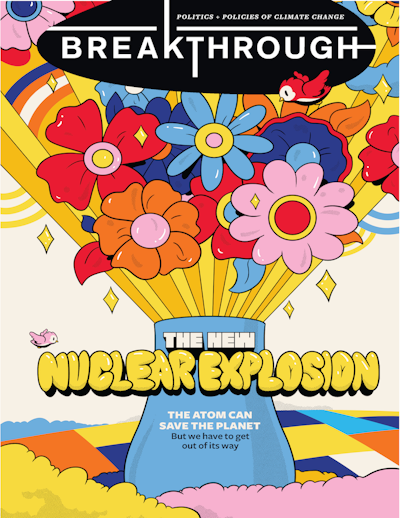The New Nuclear Explosion
Introducing Issue 18 of the Breakthrough Journal
-
-
Share
-
Share via Twitter -
Share via Facebook -
Share via Email
-
If the last two issues of this magazine have tried to add complexity to topics the mainstream climate discourse usually treats as relatively simple—what to do about agriculture and how climate change will alter geopolitics—creating this issue started from a slightly different place. If there is one certainty for the climate, it may well be the environmental benefits of nuclear power
As we at the Breakthrough Institute often point out, nuclear power generates vastly greater quantities of emissions-free electricity with far less of a land footprint than other “green” alternatives like wind and solar. It also imposes the lowest public health cost of any major energy technology. Indeed, if we don’t ramp up nuclear power in the coming years, it is unclear how the world will be able to draw down its use of fossil fuels while still generating enough power to keep modern economies ticking and provide decent living standards for everyone around the world.
Ecomodernists have been making this basic argument for years, but of late, there’s more momentum from outside the pro-nuclear movement, too.
Russia’s invasion of Ukraine in February sent natural gas markets spinning and those who rely on Russian pipelines scrambling for alternative fuels. Months later, the European Union parliament voted to designate some nuclear energy projects as “green,” opening the way to billions of euros in cheap loans and subsidies. And even anti-nuclear stalwart Germany has had to think seriously about postponing plans to close its remaining nuclear facilities. In the United States, meanwhile, President Joe Biden’s landmark climate bill, the Inflation Reduction Act (IRA), includes funding and loans for nuclear projects and uranium enrichment, and efforts to prematurely close California’s Diablo Canyon nuclear power plant recently failed.
With this friendly tailwind behind us, our fall issue, The New Nuclear Explosion, charts where nuclear may be heading next.
Policy analyst Michael Moran opens the nuclear feature with “Nuclear Dreams, Nuclear Realties,” a round-the-world tour of where nuclear is winning, where it isn’t, and why. “Nuclear energy won’t take over the entire world fast,” he finds, “but it is doggedly marching forward.” In a follow-on piece, “Atoms and Influence,” POWER Magazine editor Sonal Patel compares the current moment—complete with nuclear influencers on TikTok—to previous leaps forward for nuclear energy in world history.
From there, writer Fred Stafford zooms in on the United States to argue in “We Need a Nuclear New Deal” that Biden’s IRA presents an opportunity to revive an older American institution, the Tennessee Valley Authority, which could take its oversight of nuclear infrastructure in parts of the South nationwide to produce, at cost, reliable and constant electricity for consumers and businesses. Also focusing on the United States is Good Energy Collective’s Ariel Gould in “Nuclear’s Uranium Problem.” In her piece, she charts the damage the United States’ historical mining practices caused, especially to Native communities, and shows how the country can do better this time. “Mining does not need to be destructive. It can be rethought to include cleaning up the dirty legacy of mining’s past, protecting the environment and investing in the community,” she concludes.
Checking in on other places, in “The Sources of Germany’s Nuclear Aversion,” German Marshall Fund’s Sudha David-Wilp explains how anti-technology and anti-nuclear sentiments came to dominate the country’s Green movement after World War II—and how they might be overcome now. “Germany’s stance on nuclear may seem irrational, but it is in fact a fully logical result of a collision of history, economics, and idealism that all pointed the country down one path. And that’s a hard but important lesson for anyone puzzling over stalled nuclear programs in other countries.”
Meanwhile, Manhattan Institute’s Jordan McGillis and Taiwanese journalist Angelica Oung discuss in “Taiwan’s Nuclear Option” the increasingly good conditions for revamping the nuclear energy sector there, including an energy crunch that threatens to derail the country’s manufacturing economy if new sources of energy are not found, a desire to be independent from China, the fact that its officially “closed” nuclear power plants were never fully taken offline, and more.
Next, nuclear experts Rauli Partanen, Kirsty Gogan, and Eric Ingersoll explore the bright future of offshore nuclear power plants in “The Future of Nuclear Is at Sea.” Around the world, shipyards are only operating at 50 percent of their manufacturing capacity, and if they dedicated even a portion of that to building modular reactors on ships and oil rigs, the environmental benefits would be huge.
Finally, the Breakthrough Institute’s Seaver Wang checks in on the fighting around Ukraine’s nuclear power plants in “The Real Risks at the Zaporizhzhia Nuclear Plant.” Although nuclear critics like to point to the situation there as evidence that nuclear is not safe, he argues, “objectively, any risks to human health and the environment from the Zaporizhzhya plant remain low.” And what “minor risks do exist are overwhelmingly the fault of Russian military forces and lie wholly within the power of Russian leaders to eliminate.”
Woven through The New Nuclear Explosion are helpful charts and graphs about the environmental rewards of nuclear power reprinted from the recently released Carbon Almanac, with discussion from entrepreneur Seth Godin. And if the climate benefits aren’t convincing enough, the nuclear discussion is capped off with a look back at the decades of technological, economic, and political wins the Soviet Union reaped from pursuing nuclear between the 1970s and 1990s. In “Red, White, and Blue Atom,” his review of the book Red Atom by Sovietologist Paul Josephson, former New York Times reporter Matthew Wald urges the United States to see the similar victories it could amass by doing the same.
The arguments collected in this issue all point in one direction—that nuclear energy will have to be a big part of any Net Zero future. But within that broad understanding, they reveal much difference in strategy, prioritization, political concerns, and readiness across technologies and countries. In doing so, they both reflect the very real ways in which the basic arguments for nuclear power have won and offer some realistic guidance for where the debate should go next.

